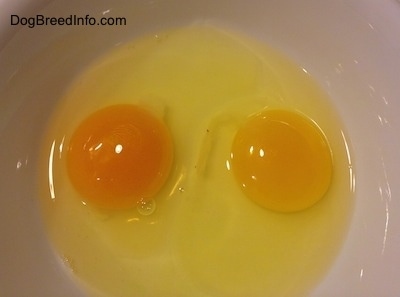
Free-range egg vs. caged store-bought egg
I have read online and even in a book that farm eggs from free-range chickens are better for you than eggs produced from chickens in cages that they sell in stores. Eggs from free-range chickens have twice as many omega-3 fatty acids, which are the good omegas that people are flocking to in the form of fish oil. They have two-thirds more vitamin A, three times more vitamin E and seven times more beta carotene. In addition, they have one-fourth less saturated fat and one-third less cholesterol.
But, can you really tell a farm fresh free-range egg from a caged store egg? I decided to put it to the test. A friend gave me one of their store-bought eggs and I got one from our own chickens. I had half expected for there to be no difference, but...
...I cracked them both into a bowl and wow! The free-range egg is to the left and the caged store-bought egg is to the right. Look at the difference in color. The farm egg is a deeper, richer orange. The yolk is full and firm. The caged egg is pale in comparison with less substance to the yolk.
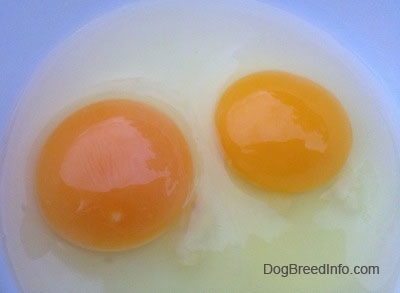
Home free-range egg vs. store-bought free-range egg
I decided to do one more test. I got a store-bought, free-range egg and cracked it next to an egg from one of our own free-range chickens. The store's free-range egg is to the right, my own chicken's egg is to the left. Once again my own chicken's egg has a firmer yolk and a deeper, richer orange color. While the store-bought, free-range egg appears to be better than the store-bought caged egg, niether of them come close to my own hen's egg. I have heard that the FDA standard for a free-range chicken says the chicken coop has to have a door leading to the outside. What most people do not realize is the door does not necessarily have to be opened every day. Therefore from what I hear most store-bought, free-range eggs come from chickens who spend most of their days uncaged, but indoors. The door leading to the outside is kept closed so often that even when it is opened the chickens usually do not venture outside. When I read this I was not sure whether or not to believe it. Surely the farmers would open the door so the chickens could go outside and actually free range, right? However after comparing these two eggs I am no longer in doubt.
The FDA likes to warn us that eating too many eggs is bad for our health. What they should be saying is too many mass produced caged eggs and so called free-range indoor chickens that are forced to eat cheap food are bad for our health.
If your township allows it, keeping your own hens is really not all that difficult.
This reminds me of the beef issue. We are all warned that too much red meat is bad for our health. The more accurate version of that is too much red meat coming from corn-fed cows is bad for our health. Cows that are fed corn produce meat that has more of the bad omega-6 fatty acids. It is the omega-6 fats that cause high cholesterol and clog the human arteries. Cows that eat grass, the food they were meant to eat, produce meat that is high in omega-3 fatty acids, the “good for you” fat.
Corn-fed cows also have high levels of E. coli in their stomachs, hence why they need to be fed antibiotics. E. coli cannot live in the stomach of a grass-fed cow; the stomach acids are not the right environment for it to thrive. Cows were not meant to eat corn. Grass-fed cows do not need to be given antibiotics, whereas a corn-fed cow would die without them. Why are the cows fed corn? Because corn is subsidized by the U.S. government, making it cheap feed. There is a big surplus of corn in the United States. Farmers who feed their cows corn instead of grass are given perks that grass-fed farmers do not get. In the meantime we are all warned not to eat too many mass produced eggs or corn-fed cows. I would go out and get a cow for the grass-fed meat the same as we do the eggs, however I am afraid the cow would become a pet (I don't eat my pets) and we would have a pet cow for the next 15 years! I'll have to stick to shopping at Whole Foods Market for my grass-fed beef. This is not just a human food issue. Read Corn in Dog Food. Really?
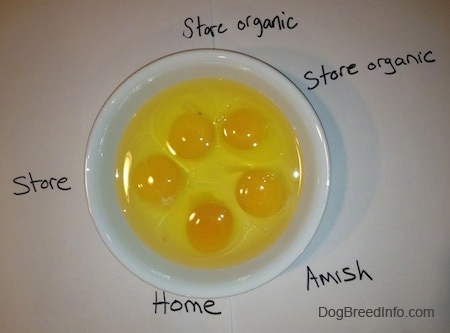
This image shows a normal store-bought egg, two different brands of store-bought, cage-free, organic eggs, an egg bought off of an Amish stand at a flea market from a local farmer and an egg from my own free range chickens. I had expected the organic cage-free eggs to look darker than the regular store egg. I also expected the local farmer' egg purchased from the Amish family would be a closer comparison to my own free-range egg, however there was not much difference between the regular store egg, the organic eggs and the Amish store egg. Nothing compared to my own free-range egg. When an egg is sold as cage-free it does not mean the same thing as a free-range egg. A cage-free egg means the chicken is not in a cage, but it is usually still indoors in a crowded space and is not that much different than the store-bought caged egg. The indoor chickens do not have a lot of room to move around in the crowded building.
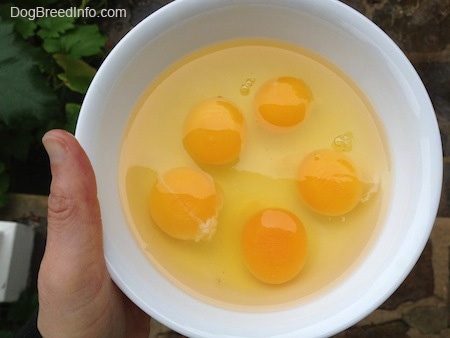
This is a picture of the same eggs as shown above. My home free-range egg is at the bottom of the picture. It is very easy to see the difference in color in person and a little harder to capture it in a picture. The home egg is a deeper orange than the other eggs. It was disappointing to see that the organic eggs look the same as the normal store-bought egg.
The eggs in the first two rows are chicken eggs. The egg in the last row is a turkey egg.
Eggs, from left to right: guinea fowl, Barred Rock (Black) chicken, Rhode Island Red chicken, turkey
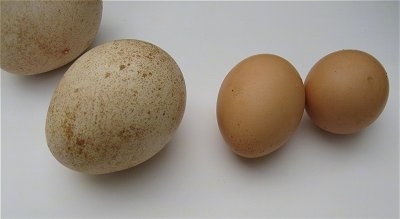
Peafowl eggs next to a medium and small chicken egg
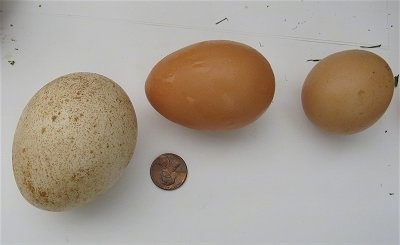
Peafowl eggs next to a medium and small chicken egg—penny for size comparison
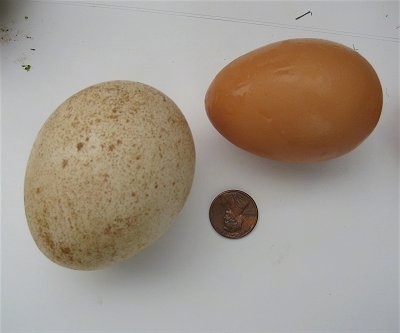
Peafowl eggs next to a medium chicken egg—penny for size comparison
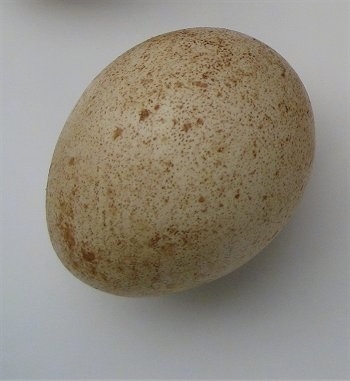
Peafowl egg
Robin's egg next to a dime and a Rhode Island Red chicken egg
Robin's egg next to a dime to show size comparison
Robin's egg
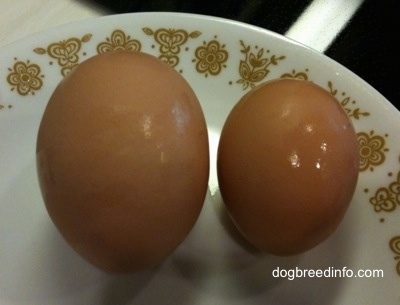
Example of two chicken eggs, both laid by chickens that are a hybrid cross between a White Rock egg-layer type female and a Rhode Island Red male. One egg is substantially larger than the other. Laid by free-range chickens that are kept as pets at a private home.
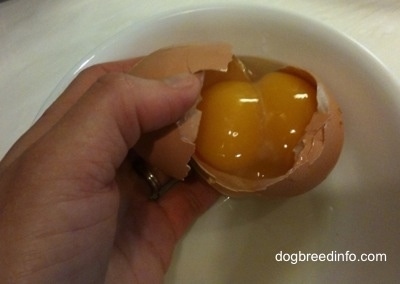
Inside the larger egg there is a double yolk.
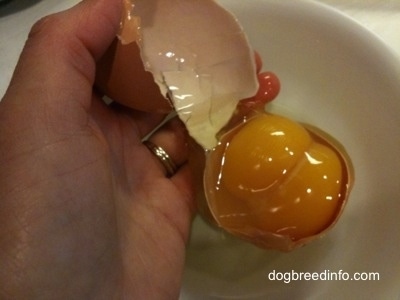

The yolks are normal size. Had this egg been fertilized and the hens allowed to lay on them, it would have been twins.
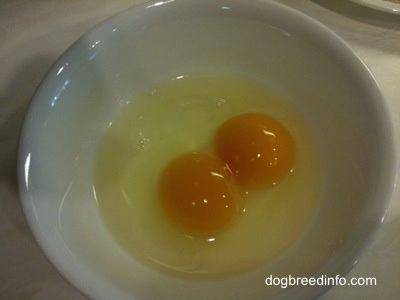
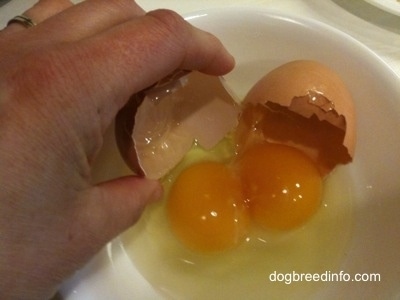
It's like getting two eggs for the price of one.
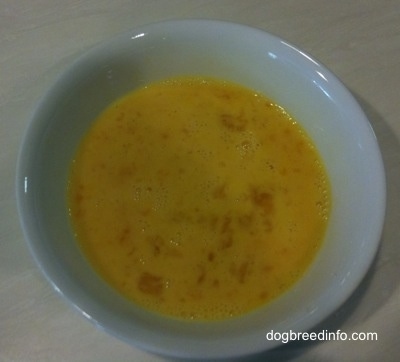
This bowl contains the double-yolked egg, the single smaller egg and a touch of milk. The eggs were beat with a fork.
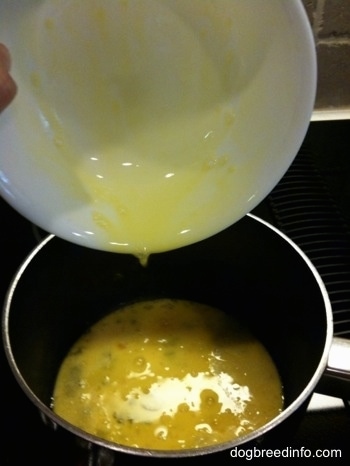
And put into a pan.
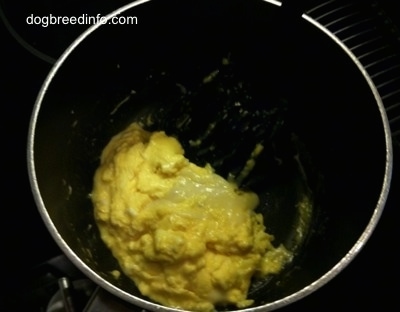
A slice of Swiss cheese was added to make a light and fluffy omelet.